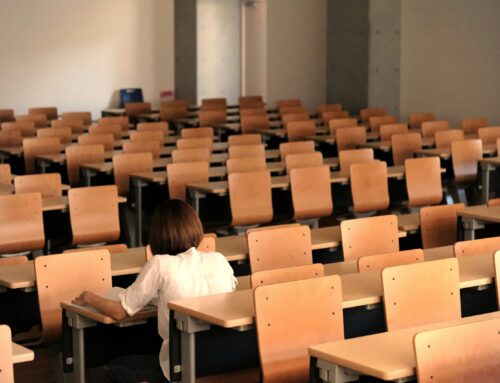 Introduction (What is Selective Attention?)
Introduction (What is Selective Attention?)
Selective attention is a fundamental ability linked to human memory and cognition, and it plays a major role in academic understanding and achievement. It is the ability to selectively process information that is relevant and specific to a task at hand, while simultaneously avoiding the processing of irrelevant, distracting information. This filtering of information is essential in understanding visual and auditory stimuli and in creating a hierarchical order of importance of each stimuli. Selective attention plays a role in managing attention span/concentration, and multitasking.[1] It helps us understand and enhance relevant signals and manage distraction. It is also essential in understanding academic foundations in subjects like language and math. While some people have the innate ability of selective attention, many people can also train to improve it. Selective attention has a major role in academic foundations, and understanding selective attention can in turn help educators understand student differences and how to support their struggling students in the classroom.[2]
Selective attention and Information Processing
One of the first attempts at understanding the effect of selective attention on information processing was done by scientist Steven Hillyard in 1973. Using the event-related brain potentials (ERPS) technique, he analyzed the neural basis of attention by comparing electrical activity in the temporal structure of the brain. In the study, participants were presented with two auditory stimuli, one in each ear, and were asked to pay attention to certain tones and to ignore others. The study showed that selective attention greatly affects neural processing. Additionally, a new paradigm was developed called the Hillyard principle, which is that “In order to assess the effects of selective attention, responses should be compared to the same physical stimuli while holding overall arousal level and task demands constant, such that all that differs is the focus of selective attention.” Since 1973 this principle has been used to examine the effects of selective attention on information processing in different subjects, with different stimuli.[3]
It has also been found that selective attention processes begin in different parts of the brain depending on the stimuli and where this information is typically processed. For example, the Wernicke’s area, located in the temporal lobe, controls speech and language comprehension. When two language stimuli are provided, the information is still processed in the Wernicke’s area, the specialized cortical area associated with processing that information.[4] The modulatory signals of selective attention originate in the brain regions that represent behavioral goals. They are subject to change based on the abstract goals that transform into targeted signals. This all acts with the ultimate goal of perceptual selection—essentially picking and choosing which information is important, and which information can be thrown away. There are two ways that perceptual selection is known to be achieved—one is “bottom-up;” it is driven by the stimuli, is physiologically involuntary, and is dependent on physical/visible prominence. The other is “top-down;” it is voluntary and done consciously, and it depends on a person’s goals. While these two core ways of understanding selective attention have been developed, it is important to note that these processes are not linear or clear-cut; they are rarely strictly confined to specific brain regions.[5] Additionally, this initial processing of information controls the amount of attention distracting stimuli receive—for better or for worse. Sometimes, the “important” information must compete with the “irrelevant” information for attention, depending on many factors like the cognitive functioning of the person’s brain, the relevance of the distracting information, or perhaps noticeable visual stimuli that a distractor might contain.[6]
Selective Attention and Mental Health
But what can inhibit someone’s ability of selective attention? Why is this ability innate in some people, but must be learned in others? And how can this information help us understand differences in students? Well, students come from all sorts of backgrounds and have different styles of cognition. Some of these differences could include disorders like anxiety, which is the most common mental illness in adolescents, or neuropsychological differences like ADHD—these all can have significant impacts on selective attention.
The ability to control selective attention starts to develop in early life, as early as infancy, but it continues to be developed in early adulthood. Truly, every person’s brain works differently depending on what stimuli they were exposed to in early life, the type of education and care they received both at home and in school, and any pre-existing conditions that could inhibit their ability to sort the information they’re presented. ADHD, though it is not a condition with a clear-cut presentation or experience, can have a major impact on selective attention. It is a complex condition, but in general, those with ADHD have a more difficult time with preferential processing, or recognizing distractors when presented with multiple stimuli. Usually, those with ADHD will struggle with bottom-up attention, which is to say, the involuntary, innate ability to hierarchize information.[7] However, individuals with ADHD might struggle more with different types of attention, such as sustained attention, alternating attention, or divided attention—it all depends on the person.[8] Similarly, those on the Autism spectrum, which is another complex and individualized condition, may struggle with selective attention in particular (and other types of attention as well) and overall have difficulty with recognizing the more important stimuli to process. This is all to say that there are many different factors within our cognitive and behavioral experiences that impact the ability to prioritize certain information.
Additionally, depression, anxiety, and other mental health issues play a large role in cognition and attention, and the prioritization of certain information over others. In fact, not only do mental health struggles like depression and anxiety cause issues focusing and dividing one’s attention, but selective attention can even potentially work to maintain a variety of clinical problems and unhealthy thinking styles within these disorders.[9] For example, within Generalized Anxiety Disorder (GAD), individuals might experience anxiety-related attentional bias, and focus on “less important” aspects of their lives, certain interactions, or stimuli. Directly targeting these dysfunctional biases in attention is actually a major strategy used in treating anxiety–it is called “attentional bias modification” (or ABM), and it aims to reduce behaviors associated with negative attentional biases.[10] Depression and anxiety are often linked. Those with depression might experience negative attentional bias as well and might pay more attention to personally relevant negative stimuli. Additionally, cognitive dysfunction is a major diagnostic criteria in Major Depressive Disorder (MDD). Cognitive problems such as this can impact learning, memory, executive functions, processing speed, and of course, attention. Cognitive dysfunction can lead to an array of issues, including but not limited to the selection and processing of relevant information when presented with multiple stimuli.[11]
Importance in Education
It is important for educators, faculty, and students alike to recognize the importance of selective attention in education, and to also understand the various factors that could be affecting an individual’s ability, or inability, to focus and hierarchize certain essential information. Teachers deal with a diversity of students in the classroom—some will be perfectly, innately capable of processing and hierarchizing information presented to them in an academic setting, and others will struggle with doing so. Inattention can manifest in a variety of ways, such as fidgeting, an inability to hold conversation, trouble keeping track of and finishing work, and much more. It is important to remember that an individual’s attentional biases and attention span do not define their intelligence, and a rigid, repetitive class structure is not guaranteed to work for everyone.[12]
Academic success, after all, is defined by a variety of factors such as socioeconomic status, personality, social awareness, and cognitive abilities, among countless others. Studies show that selective attention skills are specifically relevant to language and speech processing, literacy, and mathematics, which are core elements of the educational experience, and strongly impact whether someone will do well in school or not.[13] If not provided with the essential help needed for them to do well, students who struggle with selective attention are often left falling behind in class.
Conclusion
So, what can teachers and educators do to help? It is important to provide students with necessary resources to make them successful. This will be different based on the individual since all students are different. Some potential resources to provide could include organizational tools or strategies, helping students set manageable goals, doing individual check-ins for long-term projects, privately addressing off-task or distracting behavior, and providing meaningful rewards for hard work. This might also include taking short breaks, communicating and connecting with students effectively in order to make sure they feel heard and understood, straying away from blaming or shaming students for their struggles, and noting or praising positive behavior.
[1]https://www.pnas.org/doi/10.1073/pnas.1707241114#:~:text=Selective%20attention%20is%20the%20ability,cognitive%20skills%20and%20academic%20achievement
[2] https://www.ncbi.nlm.nih.gov/pmc/articles/PMC3375497/
[3] https://www.sciencedirect.com/science/article/pii/S1878929311001101
[4] https://www.sciencedirect.com/science/article/pii/S1878929311001101
[5] https://www.ncbi.nlm.nih.gov/pmc/articles/PMC2681259/
[6] https://www.sciencedirect.com/science/article/pii/S1878929311001101
[7] https://www.ncbi.nlm.nih.gov/pmc/articles/PMC5497785/
[8] https://spectrumfusion.org/2018/05/attention-and-cognitive-fatigue-in-adults-on-the-autism-spectrum/
[9] https://www.psychologytools.com/resource/selective-attention/#:~:text=Selective%20attention%20is%20mechanism%20which,such%20as%20depression%20or%20anxiety
[10] https://www.ncbi.nlm.nih.gov/pmc/articles/PMC4618299/
[11] https://www.nature.com/articles/s41398-019-0616-1
[12]https://www.apa.org/ed/schools/primer/inattention#:~:text=Adolescents%20with%20attention%20difficulties%20frequently,instruction%2C%20and%20preparing%20for%20exams
[13] https://www.nature.com/articles/s41398-019-0616-1




